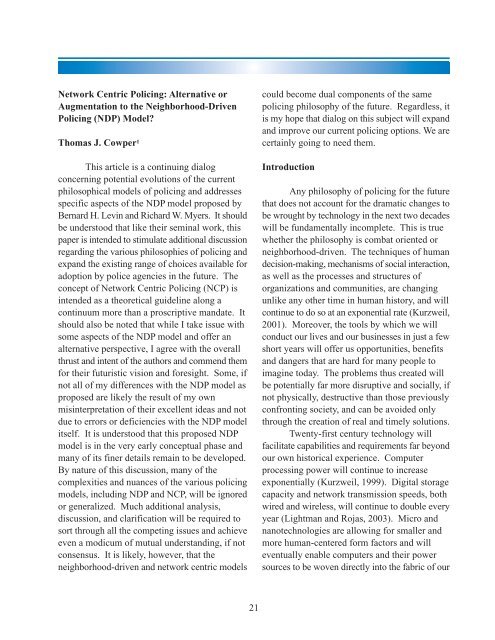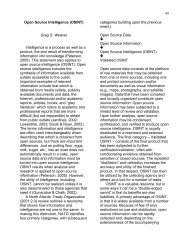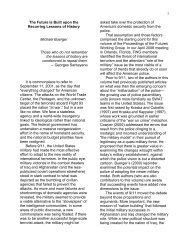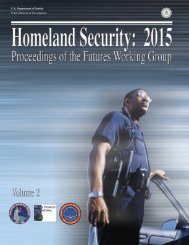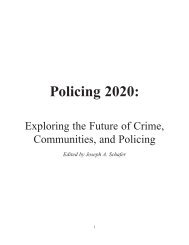Network Centric Policing - Futures Working Group
Network Centric Policing - Futures Working Group
Network Centric Policing - Futures Working Group
Create successful ePaper yourself
Turn your PDF publications into a flip-book with our unique Google optimized e-Paper software.
<strong>Network</strong> <strong>Centric</strong> <strong>Policing</strong>: Alternative or<br />
Augmentation to the Neighborhood-Driven<br />
<strong>Policing</strong> (NDP) Model<br />
Thomas J. Cowper 1<br />
This article is a continuing dialog<br />
concerning potential evolutions of the current<br />
philosophical models of policing and addresses<br />
specific aspects of the NDP model proposed by<br />
Bernard H. Levin and Richard W. Myers. It should<br />
be understood that like their seminal work, this<br />
paper is intended to stimulate additional discussion<br />
regarding the various philosophies of policing and<br />
expand the existing range of choices available for<br />
adoption by police agencies in the future. The<br />
concept of <strong>Network</strong> <strong>Centric</strong> <strong>Policing</strong> (NCP) is<br />
intended as a theoretical guideline along a<br />
continuum more than a proscriptive mandate. It<br />
should also be noted that while I take issue with<br />
some aspects of the NDP model and offer an<br />
alternative perspective, I agree with the overall<br />
thrust and intent of the authors and commend them<br />
for their futuristic vision and foresight. Some, if<br />
not all of my differences with the NDP model as<br />
proposed are likely the result of my own<br />
misinterpretation of their excellent ideas and not<br />
due to errors or deficiencies with the NDP model<br />
itself. It is understood that this proposed NDP<br />
model is in the very early conceptual phase and<br />
many of its finer details remain to be developed.<br />
By nature of this discussion, many of the<br />
complexities and nuances of the various policing<br />
models, including NDP and NCP, will be ignored<br />
or generalized. Much additional analysis,<br />
discussion, and clarification will be required to<br />
sort through all the competing issues and achieve<br />
even a modicum of mutual understanding, if not<br />
consensus. It is likely, however, that the<br />
neighborhood-driven and network centric models<br />
could become dual components of the same<br />
policing philosophy of the future. Regardless, it<br />
is my hope that dialog on this subject will expand<br />
and improve our current policing options. We are<br />
certainly going to need them.<br />
Introduction<br />
Any philosophy of policing for the future<br />
that does not account for the dramatic changes to<br />
be wrought by technology in the next two decades<br />
will be fundamentally incomplete. This is true<br />
whether the philosophy is combat oriented or<br />
neighborhood-driven. The techniques of human<br />
decision-making, mechanisms of social interaction,<br />
as well as the processes and structures of<br />
organizations and communities, are changing<br />
unlike any other time in human history, and will<br />
continue to do so at an exponential rate (Kurzweil,<br />
2001). Moreover, the tools by which we will<br />
conduct our lives and our businesses in just a few<br />
short years will offer us opportunities, benefits<br />
and dangers that are hard for many people to<br />
imagine today. The problems thus created will<br />
be potentially far more disruptive and socially, if<br />
not physically, destructive than those previously<br />
confronting society, and can be avoided only<br />
through the creation of real and timely solutions.<br />
Twenty-first century technology will<br />
facilitate capabilities and requirements far beyond<br />
our own historical experience. Computer<br />
processing power will continue to increase<br />
exponentially (Kurzweil, 1999). Digital storage<br />
capacity and network transmission speeds, both<br />
wired and wireless, will continue to double every<br />
year (Lightman and Rojas, 2003). Micro and<br />
nanotechnologies are allowing for smaller and<br />
more human-centered form factors and will<br />
eventually enable computers and their power<br />
sources to be woven directly into the fabric of our<br />
21
clothing (Mulhall, 2002). Augmented reality and<br />
augmented cognition will give one person in 2015<br />
the same productivity as three or more people<br />
today (DARPA, 2003). Radio frequency<br />
identification and computer processing chips<br />
embedded within practically every manufactured<br />
item will allow us to interact with intelligent<br />
environments (homes, highways, office spaces,<br />
and public places) that are adaptable to and intuitive<br />
of our desires (Weiser, 1996). Intelligent agents<br />
and autonomous robots will free humans from<br />
today's mundane and trivial tasks that take very<br />
little creative intelligence but eat up inordinate<br />
amounts of time and detract from human<br />
productivity and leisure (Kotz and Gray, 1999).<br />
Cybernetic implants will enhance human<br />
performance and speed the exchange of information<br />
between the digital and biological world, creating<br />
a ubiquitous network of interconnected information<br />
nodes (Clark, 2003).<br />
Twenty-first century police agencies must<br />
exploit these capabilities if they are to effectively<br />
serve their communities in the future, irrespective<br />
of the definition applied to "service" within a<br />
particular jurisdiction. The technology to gather,<br />
process, collate, analyze, and distribute information<br />
and intelligence in real-time to the right people at<br />
the right time in the right format will be available<br />
and increasingly more affordable. Businesses,<br />
non-police organizations, citizens, and our criminal/<br />
terrorist adversaries will take advantage of these<br />
capabilities. Police officers of the future must be<br />
able to compete in this future world. They will<br />
require the high degree of situational awareness<br />
provided by ubiquitous information and<br />
communication systems, advanced human-machine<br />
interfaces, and improved personal mobility. For<br />
law enforcement to be successful against the threats<br />
of the future and truly serve our communities,<br />
neighborhoods, and jurisdictions, we have to be<br />
flexible, adaptable, and reconfigurable, bringing<br />
together the appropriate resources and personnel<br />
to tackle whatever a rapidly changing situation<br />
warrants. The only way to accomplish this is<br />
through the proactive and intelligent use of<br />
emerging technologies.<br />
NDP: Industrial or Information Age<br />
The Levin/Meyers NDP model addresses<br />
this aspect of our future and acknowledges many<br />
of these points. It focuses quite correctly on the<br />
growing incompatibility of our traditional industrial<br />
age policing models with the information age and<br />
acknowledges the movement toward human<br />
networks and away from bureaucratic hierarchies.<br />
It notes the speed of communication and the use<br />
of modern technologies to facilitate interactive<br />
information sharing. However, it is not clear to<br />
me how the "neighborhood leading itself and<br />
deciding its own fate" necessarily translates into<br />
an information age model. This issue of industrial<br />
vs. information paradigms in the 21st century is,<br />
I believe, much more significant than the NDP<br />
model seems to suggest and requires a much more<br />
significant and fundamental restructuring than<br />
merely shifting authority from police to the<br />
neighborhood. NDP seems on its face primarily<br />
a philosophy of governance and accountability,<br />
another step along an evolutionary path from<br />
combat policing, to community oriented policing,<br />
to NDP - a further shift in the locus of control.<br />
This shift is, I think, appropriate in some cases,<br />
perhaps ultimately. But theoretically, under the<br />
NDP model a police department could continue<br />
to operate in an industrial age mode as long as<br />
the "neighborhood" controlled the delivery of<br />
police services and was apparently content with<br />
them.<br />
22
In that sense, the NDP model by itself may<br />
not fully achieve the kind of change necessary for<br />
success in the coming decades. Changing the<br />
locus of control over delivery of police services<br />
from the police to the neighborhood, while<br />
theoretically desirable and perhaps achievable in<br />
many communities, addresses a philosophical<br />
issue of governance and authority but does not by<br />
itself move policing from the industrial to the<br />
information age, nor solve the very significant<br />
problems associated with the delivery of police<br />
services within the context of the overall public<br />
safety arena in a fast-paced world. Without a<br />
corresponding and dramatic change in<br />
community/police organization, management,<br />
structure, operational methodology, and technology,<br />
NDP might easily slow police decision-making,<br />
bogging it down in the hierarchical processes of<br />
its combat and community oriented predecessors<br />
through the centralized morass of an inefficient<br />
neighborhood board.<br />
That neighborhood board, in most cases<br />
composed of unpaid community volunteers, may<br />
be very traditional in its governing processes and<br />
could easily be slower and more cumbersome than<br />
a traditional police bureaucracy in responding to<br />
community problems. Moreover, untrained<br />
community members may not have the skills or<br />
the desire necessary to drive improvements in the<br />
decision-making process. They may not be<br />
equipped mentally, psychologically, or culturally<br />
to cope with the radical technological changes<br />
required to move away from the industrial age<br />
paradigm they grew up with and might stifle police<br />
desires to improve and modernize. It may lock a<br />
neighborhood into an industrial age police<br />
methodology and allow isolation in operation,<br />
information sharing and interagency cooperation<br />
or interoperability. This may suit the board and<br />
may satisfy the desires of a particular local<br />
population but it does not address the fundamental<br />
aspects of the information age that are dramatically<br />
impacting the broader public safety arena as well<br />
as the majority of police agencies in regards to<br />
crime, terrorism, and community (or<br />
neighborhood) peace, prosperity, and security.<br />
I do not believe the neighborhood is the<br />
"only effective level" of homeland security as the<br />
authors suggest. Crimes, terrorist attacks, disasters,<br />
and public safety events are not exclusively or<br />
even predominantly local in nature. Rather,<br />
homeland security, crimes, disasters, traffic safety,<br />
order maintenance, and other public safety<br />
concerns, in the information age rapidly becoming<br />
the wireless information age, (Lightman and Rojas,<br />
2003) are in fact most often multi-jurisdictional<br />
in nature. Criminals are more mobile today and<br />
their crimes, criminal enterprises, and the problems<br />
they create for society impact large regions while<br />
being multi-faceted and complex to solve. Further,<br />
these issues are best dealt with when coordinated<br />
"globally" with a strategic or unified orientation,<br />
not piecemeal and haphazardly by isolated<br />
departments with a parochial local predisposition.<br />
Effective homeland security, as well as the<br />
provision of public safety services, now and in<br />
the future, requires close and continuous<br />
coordination and cooperation across the spectrum<br />
of social resources and organizations, both<br />
geographically and electronically. To be effective<br />
this coordination and cooperation must occur at<br />
all levels of government (federal, state, and local),<br />
among all governmental sectors (police, fire, EMS,<br />
transportation, social services, military), between<br />
the public and private sectors (corporate security,<br />
business, not for profit), and between public<br />
servants and public citizens, within the<br />
neighborhood and otherwise.<br />
This does not mean to imply the need for<br />
centralized control, highly structured processes<br />
and policies, or the imposition of rigid standards<br />
of operation. On the contrary, the information<br />
23
age increasingly negates attempts to control,<br />
structure, and standardize. Fluid, dynamic, and<br />
seemingly chaotic processes will undoubtedly<br />
solve many of tomorrow's complex problems, but<br />
it is the unified, universal, and real-time sharing<br />
of useful information between all interested parties,<br />
groups and individuals that will be at the core of<br />
those processes. Access to all manner of<br />
information will be a requirement of this chaotic<br />
information age world that is increasingly<br />
interconnected and interdependent.<br />
While none of this negates the validity, or<br />
even the desirability of the NDP model in many<br />
circumstances, there is, I believe, more to moving<br />
the policing world into the 21st century than simply<br />
shifting some departments, if their citizens so<br />
choose, to neighborhood control. We are in fact<br />
moving towards a network oriented social order<br />
- an interconnected web of individuals.<br />
Communication, information access, knowledge<br />
acquisition, and the individual productivity that<br />
results from them are the hallmarks of our<br />
collective future and derive from the growing<br />
connected array of individuals and their shared<br />
sources of information. This "network centric"<br />
society based upon the real-time and ubiquitous<br />
sharing of information is at the heart of today's<br />
technological advancement, driving radical social,<br />
political, economic, and cultural change in our<br />
world. It is the result of an increasing availability<br />
of useful, appropriate, and timely data, specifically<br />
tailored to an individual’s environment, problems,<br />
and relationships. This immediate access to the<br />
right data in real time is changing people,<br />
organizations, and human interaction. Success in<br />
this new world (individual, organizational, and<br />
social) is dependent upon our continued ability to<br />
adapt, live within, and effectively apply net-centric<br />
principles and the technologies that support them<br />
(Alberts, et al, 1999).<br />
The Theory<br />
<strong>Network</strong> <strong>Centric</strong> <strong>Policing</strong> moves police<br />
organization and operation from the industrial age<br />
construct of centralized bureaucratic control, rigid<br />
hierarchical structures, systematic managerial<br />
processes, with formalized and authorized official<br />
policies and agreements, to a less structured, noncentralized,<br />
real-time association of interconnected<br />
individuals acting with regard to common goals.<br />
It is a philosophy that is fully compatible with,<br />
and capitalizes upon the tools and dynamics of<br />
the information age. The old models concern<br />
themselves with procedure, policy, order, and<br />
control. Their philosophy is one of process,<br />
command, and strict accountability. The NCP<br />
philosophy sets aside those concerns and<br />
concentrates on the product, on achieving success,<br />
on increasing individual productivity, on<br />
maximizing the distribution of information to<br />
solve real problems. The goal is achieving<br />
effective and appropriate solutions quickly in a<br />
rapidly changing environment. NCP requires a<br />
completely new culture of control, a new structure,<br />
new operational methodologies, and the emerging<br />
technological tools to facilitate them. It is a<br />
philosophy that embraces information age<br />
technology to maximize human productivity and<br />
effectively and efficiently solve human problems.<br />
This network centric business or<br />
operational paradigm has been under development<br />
within the corporate world and the military for<br />
many years. In theory, net-centric operations are<br />
those where highly networked personnel draw on<br />
information from the widest variety of sources,<br />
including fixed and mobile sensors, and on-line<br />
databases, in real-time, and maximize the sharing<br />
of the accumulated information throughout the<br />
entire network continuously. This is much more<br />
than simply sharing information with fellow<br />
workers. The purpose of the NCP model is to<br />
24
analyze and share information in a way that<br />
improves the overall quality of the information<br />
and thereby increases a shared situational and<br />
organizational awareness for everyone on the<br />
network. Improved overall awareness enables<br />
more effective and appropriate collaboration<br />
through the creation of mutual mental models<br />
(MMMs) which foster self-synchronization<br />
throughout the entire organization--the process<br />
whereby highly informed groups organize and<br />
direct their collective yet distributed activities<br />
from the bottom up, without centralized command<br />
or control but operating within a framework of<br />
organizational intent. This in turn creates a much<br />
more effective and efficient organization,<br />
accelerating and coordinating the accomplishment<br />
of all tasks to rapidly achieve organizational<br />
goals (Hutchins, et al, 2001).<br />
The Concept<br />
A net-centric police agency would be<br />
intricately connected, internally and externally.<br />
The "network" in this case is not just IT hardware<br />
but would consist of people (all agency personnel<br />
and local citizens), computers, databases, all<br />
manner of digital information derived from<br />
intelligence sources and sensors (e.g.,<br />
neighborhood watch groups, private security<br />
guards, security and surveillance cameras,<br />
autonomous robots and unmanned aerial vehicles<br />
(UAVs)), information from other<br />
agencies/organizations (local, state and federal<br />
government, along with information from<br />
citizens, the neighborhood, the larger community,<br />
and an entire region). It would use this network<br />
to generate, collate, analyze, and distribute<br />
information to everyone who needs it, in real<br />
time, in the manner required to best utilize it to<br />
achieve positive policing results. The purpose<br />
of this information network is not simply to<br />
provide individual officers appropriate information<br />
at a specific time and place, though that is certainly<br />
desirable. The main purpose of the network is to<br />
provide everyone a comprehensive picture of:<br />
The organization its mission, goals, current<br />
priorities, ongoing activities, unit<br />
deployments, organizational intent, and<br />
His or her immediate and local context.<br />
These two continuously changing pictures<br />
combine to form a unique and detailed shared<br />
organizational awareness and enhanced situational<br />
awareness for every individual member of the<br />
agency. From this awareness flow the MMMs<br />
that allow all members to quickly make decisions<br />
and act in ways that are:<br />
Coordinated,<br />
Consistent,<br />
Effective,<br />
Mutually supporting, and<br />
Self-synchronizing.<br />
In other words, with the right information,<br />
provided at the right time, within a commonly<br />
understood context, in a way that is useful and<br />
appropriate to every individual, there is no need<br />
for orders to be passed up and down a chain of<br />
command, no need for detailed and specific<br />
managerial directions and supervisory oversight<br />
for every situation, and no need for all of the<br />
bureaucratic industrial age processes that slow<br />
traditional police operations to a crawl and force<br />
agencies into a reactive instead of a proactive<br />
posture. Every member understands what he/she<br />
needs to accomplish, why he/she needs to<br />
accomplish it, the current parameters of<br />
organizational (commander's, community's or<br />
neighborhood's) intent, and the information<br />
necessary to do so quickly and effectively.<br />
25
The concept of organizational intent is the<br />
unifying or controlling component of the NCP<br />
model. It forms the contextual basis for all actions<br />
within the organization. It consists not of direction,<br />
orders, or specific commands but of guidance: a<br />
generalized framework from which MMMs and<br />
self-synchronization can flow. In fact, there are<br />
organizational aspects of command, responsibility,<br />
and accountability that will be with us long into<br />
the future no matter how quickly we transition to<br />
the information age, but these aspects can all be<br />
retained within the NCP model. A fully networked<br />
organization, where everyone knows where<br />
everyone else is, what they are doing, and why<br />
they are doing it is inherently conducive to<br />
accountability.<br />
This concept could also facilitate adoption<br />
of the NCP model itself to either of the combat or<br />
community oriented policing philosophies (though<br />
not without significant cultural and organizational<br />
modification), and most readily to the proposed<br />
NDP philosophy of Levin and Meyers. By<br />
applying respectively the commander's, the<br />
community's, or the neighborhood's intent within<br />
a net-centric model, each of these philosophies,<br />
generally speaking, could be accommodated.<br />
Table 1 compares the net-centric model with the<br />
combat, community and neighborhood-driven<br />
models. In any case, most departments require a<br />
transitional phase from one philosophy to another.<br />
By adopting the less bureaucratic, less authoritarian<br />
organizational intent concept, agencies might be<br />
able to slowly transition from hierarchical structures<br />
and reactive methodologies simply by continuously<br />
upgrading technology and learning to selfsynchronize<br />
over time. It must be remembered<br />
however, that the more structure, hierarchy, and<br />
centralized direction an organization retains, the<br />
less effective the model will be in relation to others<br />
farther along the transitional path. But with a<br />
basic understanding of net-centric principles and<br />
a desire to improve over time, any agency could<br />
transition its current policing philosophy into an<br />
information age net-centric model.<br />
This conceptual model is quite obviously<br />
incomplete and will require the detailed<br />
consideration of a host of additional factors in<br />
order to be successful, such as:<br />
Conclusion<br />
Resource acquisition and allocation,<br />
Recruiting, hiring, and training,<br />
Specialization vs. generalization,<br />
Sworn members vs. civilian employees,<br />
Agency and community/neighborhood<br />
interaction,<br />
Technology,<br />
Logistic support, and<br />
Administration.<br />
Emerging and powerful technologies are<br />
driving change, both in the overall social and<br />
cultural context, and in our personal everyday<br />
lives. To be competitive and successful in a digital<br />
world requires an ability to confidently adapt to<br />
this changing landscape, creatively incorporating<br />
new tools and concepts into our lives while<br />
continuously evolving our business models and<br />
organizational processes to take advantage of<br />
them.<br />
NCP could be this next evolutionary step<br />
for the operation of police agencies in the 21st<br />
century. Many of society's businesses and<br />
militaries, as well as its criminal and terrorist<br />
adversaries, are switching or have already adapted<br />
to a similar decentralized and self-synchronizing<br />
model of operation. If the policing profession<br />
cannot make a similar paradigm shift we may find<br />
ourselves being of little practical service to our<br />
communities and neighborhoods in the future.<br />
This shift cannot be accomplished by traditional<br />
26
police agencies overnight. The leap would be too<br />
great. Therefore, we must begin the slow<br />
evolutionary shift immediately. The technological<br />
tools to facilitate the NCP model are emerging<br />
today. Centralized combat and community based<br />
approaches could be transitioned to the noncentralized,<br />
self-synchronized NCP model while<br />
retaining their combat-oriented or communityoriented<br />
philosophies in the short-term. The NDP<br />
model would appear to be an even better fit.<br />
Endnotes<br />
1 Thomas Cowper is a Staff Inspector with the NY State Police and<br />
the Associate Director in charge of Engineering and Technology<br />
for the Statewide Wireless <strong>Network</strong> within NY State's Office for<br />
Technology.<br />
References<br />
Alberts, D.S., Garstka, J.J., and Stein, F.P. (1999).<br />
<strong>Network</strong> <strong>Centric</strong> Warfare: Developing and<br />
Leveraging Information Superiority,<br />
2nd Edition<br />
At URL http://www.dodccrp.org/<br />
publications/pdf/Alberts_NCW .pdf<br />
accessed 10/26/2004.<br />
Clark, A. (2003) Natural Born Cyborgs:<br />
Minds, Technologies, and the Future of<br />
Human Intelligence. New York:<br />
Oxford University Press.<br />
Columbia University. (undated).<br />
MARS Mobile Augmented Reality<br />
Systems. Retrieved from http://www.cs.<br />
columbia.edu/graphics/projects/mars/<br />
mars.html accessed 08/03/2003.<br />
DARPA, (2003). Information Processing<br />
Technology Office, Augmented<br />
Cognition Program, Program Objectives<br />
FY02-FY06. At URL<br />
http://www.darpa.mil/ipto/programs/<br />
augcog/documents/AugCogFor<br />
Subcontractors.pdf accessed 08/04/2003.<br />
Hutchins, S.G., Kleinman, D.L., Hocevar, S.P.,<br />
Kemple, W.G., and Porter, G.R. (2001).<br />
Enablers of Self-Synchronization for<br />
<strong>Network</strong>-<strong>Centric</strong> Operations: Design of<br />
a Complex Command and Control<br />
Experiment. At URL http://www.dodccrp.<br />
org/6thICCRTS/Cd/Tracks/Papers/Track5/<br />
110_tr5.pdf accessed 08/04/2003.<br />
Kotz, D. and Gray, R. (1999).<br />
Mobile Agents and the Future of the<br />
Internet. At URL http://www.cs.dartmouth.<br />
edu/~dfk/papers/kotz:future2.pdf<br />
accessed 08/04/2003.<br />
Kurzweil, R. (1999). The Age of Spiritual<br />
Machines: When Computers Exceed<br />
Human Intelligence. New York: Viking.<br />
Kurzweil, R. (2001). The Law of Accelerating<br />
Returns. At URL http://kurzweilai.net/<br />
meme/frame.htmlmain=/articles/<br />
art0134.html accessed 08/03/2003.<br />
Lightman, A. and Rojas, W. (2003). Brave New<br />
Unwired World: The Digital Big Bang and<br />
the Infinite Internet. New York: Wiley.<br />
Mulhall, D. (2002). Our Molecular Future:<br />
How Nanotechnology, Robotics, Genetics<br />
and Artificial Intelligence Will Transform<br />
Our World. Buffalo, NY: Prometheus<br />
Books.<br />
Weiser, M. (1996). Open House. New York<br />
University. At URL http://www.ubiq.com/<br />
hypertext/weiser/wholehouse.doc<br />
accessed 08/03/2003.<br />
27
Table 1. Comparison of <strong>Policing</strong> Models<br />
Combat Community Neighborhood Net-<strong>Centric</strong><br />
Oriented Oriented Driven<br />
Control Centralized De-Centralized, Neighborhood, Organizational<br />
Community Police Input Intent<br />
Input Commander, or<br />
Community, or<br />
Neighborhood<br />
Structure Hierarchical Flatter Neighborhood Human <strong>Network</strong><br />
Hierarchy Determined<br />
Method of Reactive Problem Neighborhood Self-<br />
Operation Response Oriented Determined Synchronization<br />
Mutual Mental<br />
Models<br />
28


